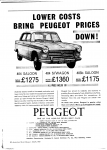Peugeot had made its name in Australia by its Round Australia wins with both the 203 and 403. After the Mobil and Ampol Round Australia Trials of 1958 there had been a gap in long rallies. In 1964 Ampol announced a 7000 mile Round Australia Trial. Director was Carl Kennedy who had driven the lead 203 in the 1955 Redex Trial and had been provisional winner before being relegated to 5th place on appeal.
In 1963 the 404 had won the East African Safari and a 403 the long Argentine Rally. A 404 was used as route car and it was expected Peugeot would do well.
Peugeot really needed a win here. The Australian 404 launch had been mishandled. The car had not been released until late 1962 and it was over priced. Sales had slumped. So Continental and General Distributors entered a strong works team of three cars. Drivers were Jack Murray/Roy Denny, Bob Holden /Monty Love and Ron Green/ David Johnson.
Works teams were also entered for Ford, VW, Skoda and Toyota. All parts could be replaced except the engine so Ford, Toyota and VW had extensive ground support with vehicles and GMH dealers were told to assist their cars. The Ford Cortinas had an advantage of an extensive range of homologated rally options. There were two private Peugeot entries, including a 404 by Alan Crabbe of Ballarat. He was a used car dealer specialising in Peugeots and had driven a 203 to 55th place in the 1958 Ampol Trial.
In 1963 the 404 had won the East African Safari and a 403 the long Argentine Rally. A 404 was used as route car and it was expected Peugeot would do well.
Peugeot really needed a win here. The Australian 404 launch had been mishandled. The car had not been released until late 1962 and it was over priced. Sales had slumped. So Continental and General Distributors entered a strong works team of three cars. Drivers were Jack Murray/Roy Denny, Bob Holden /Monty Love and Ron Green/ David Johnson.
Works teams were also entered for Ford, VW, Skoda and Toyota. All parts could be replaced except the engine so Ford, Toyota and VW had extensive ground support with vehicles and GMH dealers were told to assist their cars. The Ford Cortinas had an advantage of an extensive range of homologated rally options. There were two private Peugeot entries, including a 404 by Alan Crabbe of Ballarat. He was a used car dealer specialising in Peugeots and had driven a 203 to 55th place in the 1958 Ampol Trial.

